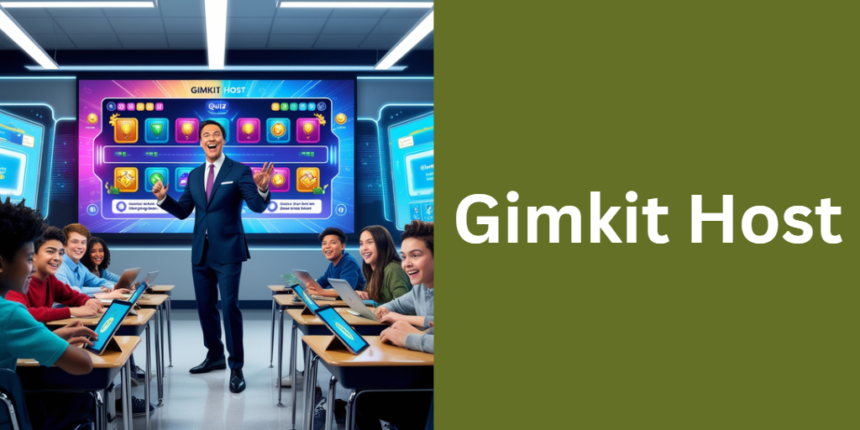Gimkit is an innovative, web-based quiz platform that transforms traditional classroom assessments into interactive, game-like experiences. Unlike conventional quizzes, Gimkit offers dynamic features such as power-ups and strategic gameplay elements, which foster a competitive yet supportive learning environment.
At its core, the platform is designed to make learning fun, reinforce knowledge, and increase student engagement.
The Role and Importance of a Gimkit Host
A gimkit host plays a pivotal role in orchestrating these learning experiences. As the facilitator, you are responsible for setting up the game, guiding your students through the gameplay, and monitoring progress in real time. Your leadership not only ensures that the session runs smoothly but also motivates students to actively participate and absorb the material. This guide aims to empower you with the knowledge and skills required to become an effective Gimkit host.
Objectives of This Guide
This article will walk you through every stage of the Gimkit hosting process—from setting up your account and designing your first game to troubleshooting common issues and exploring advanced analytics. By the end of this guide, you will be equipped with the tools necessary to create an engaging and interactive learning environment, ultimately positioning you as a leader in gamified education.
Getting Started with Gimkit as a Host
Embarking on your journey as a gimkit host begins with setting up your account and familiarizing yourself with the platform’s features. The process is simple and designed to get you up and running quickly.
Creating Your Gimkit Account
The first step involves visiting the Gimkit website and signing up for an account. During registration, you’ll be guided through a straightforward process that includes verifying your email address and setting up your profile. This initial setup is crucial, as it ensures you can access all the tools and features Gimkit offers.
After verification, spend some time personalizing your profile to reflect your teaching style and objectives.
Navigating the Gimkit Dashboard
Once logged in, the Gimkit dashboard is your central hub for game creation and management. This intuitive interface is organized into several sections, each dedicated to different aspects of game hosting. You’ll find options for creating new games, reviewing past sessions, and accessing analytics that reveal how your students are performing. Familiarize yourself with the dashboard layout to quickly locate the features you need during your live sessions.
Setting Up Your First Game
Designing your first Gimkit game is an exciting opportunity to blend creativity with educational objectives. This section guides you through the essentials of game setup and effective question crafting.
Game Creation Essentials
To start a new game, click on the “Create New Game” option on your dashboard. Here, you can select the game mode that best fits your lesson plan. Whether you opt for a timed quiz or a challenge mode, the settings allow you to tailor the game to your students’ needs. During this phase, consider the learning objectives you wish to reinforce and choose a format that promotes active participation.
Crafting Effective Questions
Developing engaging questions is at the heart of an effective Gimkit game. Focus on creating clear, concise questions that cover key topics. To further enhance engagement, incorporate multimedia elements such as images or videos where relevant. This diversity not only caters to various learning styles but also keeps the content fresh and interesting. For a quick reference, consider the following guidelines:
- Clarity: Ensure each question is straightforward.
- Relevance: Align questions with your lesson objectives.
- Variety: Use a mix of question types (multiple-choice, true/false, etc.).
Customizing Game Settings
Gimkit provides numerous options to customize the game experience. You can adjust parameters such as time limits, point multipliers, and even integrate power-ups that add strategic depth to the session. These settings enable you to create a balanced environment where students are challenged but not overwhelmed. Experiment with different configurations to determine what works best for your class.
Hosting a Live Game Session
The real-time management of a Gimkit game is where your skills as a gimkit host truly shine. From initiating the session to keeping your students engaged throughout, careful planning and dynamic management are key.
Starting Your Game Session
Before you begin, generate a unique game code that your students will use to join the session. Share this code through your preferred communication channels—whether it’s your school’s learning management system, email, or a messaging platform. A pre-session checklist can be immensely helpful, ensuring all technical aspects are in place for a smooth start.
Real-Time Management Tools
During the live session, your dashboard provides real-time insights into student progress. You can monitor scores, observe response patterns, and adjust game parameters as needed. For example, if you notice a dip in participation, consider pausing the game to provide additional instructions or encouragement. The following table summarizes some key real-time tools available to you as a gimkit host:
| Tool/Feature | Purpose | Usage Tip |
|---|---|---|
| Live Scoreboard | Tracks student performance instantly | Use it to identify top performers and laggards |
| Pause/Resume Option | Allows temporary halting of the game | Utilize this during brief explanations or discussions |
| In-Game Adjustments | Modify settings on the fly | Adjust time limits if questions are too challenging or too easy |
Engaging Your Students
Active engagement is essential for a successful session. As a gimkit host, employ strategies such as encouraging friendly competition, recognizing achievements, and incorporating moments for reflection between rounds. These practices not only keep the energy high but also facilitate deeper learning as students discuss and analyze their responses.
Advanced Features and Analytics for Gimkit Hosts
For educators seeking to elevate their teaching methods, Gimkit offers advanced features that provide valuable insights and additional game modes to explore.
Exploring Advanced Game Modes
Beyond the basic quiz format, Gimkit offers a range of game modes that cater to different learning styles. Whether you want to foster collaboration through cooperative challenges or spark a competitive spirit with head-to-head matches, there is a mode that suits your objectives. Advanced game modes encourage students to engage in strategic thinking and teamwork, thereby enhancing their overall learning experience.
Data Analytics and Performance Tracking
One of the most powerful aspects of being a gimkit host is the access to detailed analytics. After each session, the reporting dashboard provides a wealth of data, including individual scores, time spent on each question, and overall class performance trends. Analyzing this data allows you to pinpoint areas where students excel or struggle, enabling you to tailor future lessons accordingly. Consider the following sample breakdown:
| Metric | Description | Benefit |
|---|---|---|
| Average Score | The mean score of all students | Helps gauge overall class understanding |
| Question Accuracy Rate | Percentage of correct responses per question | Identifies difficult topics needing further review |
| Engagement Levels | Time spent actively participating | Assesses how well students are interacting with the content |
Integrations with Other Educational Tools
Gimkit can be seamlessly integrated with various learning management systems (LMS) and educational apps. This interoperability not only streamlines your workflow but also enriches the learning environment by connecting disparate tools into a cohesive system. For instance, linking Gimkit with your LMS allows you to import class rosters and export performance data, making it easier to track progress over time.
Best Practices for Effective Gimkit Hosting
Success as a gimkit host is not solely about mastering the technical aspects of the platform—it also involves careful planning, engagement strategies, and post-session analysis.
Pre-Session Planning and Preparation
Effective sessions begin long before the game starts. Allocate time for lesson planning that incorporates the unique elements of gamified learning. Develop backup plans to address potential technical issues, ensuring that the learning process remains uninterrupted. A brief pre-session rehearsal can also be invaluable, allowing you to familiarize yourself with the game settings and troubleshoot any potential glitches.
Maximizing Student Engagement
To maximize engagement, create a dynamic learning environment that caters to diverse student needs. Here are a few strategies:
- Incorporate Storytelling: Frame your questions within a narrative that captures students’ imaginations.
- Encourage Collaboration: Design certain rounds where teamwork is essential, fostering a sense of community.
- Provide Immediate Feedback: Use in-game feedback to help students understand their mistakes and celebrate their successes.
Post-Session Analysis and Feedback
After each session, take time to review the analytics provided by Gimkit. This post-session analysis is crucial for understanding what worked well and what could be improved. Collect feedback from your students using surveys or open discussions. Reflect on this input to refine future sessions, ensuring that each game becomes more engaging and effective than the last.
Success Stories and Case Studies
Real-world examples can inspire and guide you in your journey as a gimkit host. Teachers around the world have successfully integrated Gimkit into their classrooms, leading to improved engagement and academic performance. For instance, one case study highlighted a classroom where interactive quizzes led to a 30% increase in student participation and a notable improvement in test scores.
Another educator shared how the integration of competitive and cooperative game modes helped foster both individual excellence and team collaboration. These success stories not only illustrate the platform’s versatility but also provide practical insights into how you can implement similar strategies in your classroom.
Future Trends in Gamified Learning
The world of educational technology is constantly evolving, and gamified learning is no exception. Emerging trends indicate that platforms like Gimkit will continue to introduce innovative features designed to enhance the interactive learning experience. Expect improvements in artificial intelligence integration, which will offer personalized learning paths based on real-time performance data.
Additionally, future updates may include more robust integrations with virtual and augmented reality, further bridging the gap between digital and traditional learning environments. Staying informed about these trends will ensure that you, as a gimkit host, remain at the forefront of educational innovation.
FAQ’s About Gimkit Host
1. How does Gimkit ensure student privacy and data security?
Gimkit is committed to protecting student information by using industry-standard encryption and following best practices for data security. The platform complies with various educational data protection regulations and regularly updates its security protocols. As a gimkit host, you can trust that the platform maintains strict privacy measures, ensuring that all user data is stored securely and accessed only by authorized personnel.
2. What strategies can be employed to effectively use Gimkit in remote or hybrid learning environments?
While the guide focuses on classroom applications, Gimkit also excels in remote and hybrid settings. Educators can schedule synchronous sessions via video conferencing tools and share game codes through online learning management systems or email. To create an engaging remote experience, consider incorporating breakout sessions where students collaborate in smaller groups, or use the platform’s chat features to encourage discussion and immediate feedback. These adaptations help maintain interactivity even when students are not physically present.
3. Are there professional development resources available to help new Gimkit hosts enhance their skills?
Yes, Gimkit offers several avenues for professional growth that extend beyond the initial setup and game creation processes. Many educational technology conferences now include workshops on gamification, and there are numerous webinars hosted by experienced educators that focus specifically on maximizing Gimkit’s potential. Additionally, a variety of online communities and forums exist where gimkit hosts can share experiences, exchange innovative ideas, and receive mentorship from seasoned users.
4. How can Gimkit be tailored to accommodate students with special needs or diverse learning styles?
Gimkit’s versatility allows educators to design experiences that cater to various learning abilities. For example, you can integrate multimedia elements—such as images, audio clips, or video content—to support visual and auditory learners. The platform’s customizable question formats enable you to adjust the complexity of content, thereby providing accommodations for students who require additional support. This flexibility ensures that every learner, including those with special needs, can engage with the material in a way that suits their individual strengths.
5. How can I measure the long-term impact of using Gimkit on student learning outcomes?
To assess the enduring effects of gamified learning through Gimkit, consider combining short-term analytics with longitudinal assessments. Beyond the immediate session data, implement periodic reviews that compare students’ performance over time. You might track changes in test scores, participation levels, and overall engagement through a series of assessments or surveys administered throughout the academic term. Using this comprehensive approach will provide a clearer picture of Gimkit’s influence on sustained learning outcomes.
Conclusion
In summary, becoming an effective gimkit host involves a blend of technical know-how, creative lesson planning, and dynamic student engagement strategies. This guide has walked you through every step—from account creation and game design to real-time session management and post-session analysis.
Armed with these insights, you are now well-prepared to create memorable and impactful gamified learning experiences for your students. We encourage you to experiment with different techniques, gather feedback, and continuously refine your approach. Embrace the journey of gamified education, and let your role as a gimkit host inspire both you and your students to achieve greater academic success.
By following this comprehensive guide, you have gained a robust understanding of what it means to be a successful gimkit host. Remember, the key to continuous improvement lies in your willingness to adapt, experiment, and learn from every session. Happy hosting and here’s to transforming the way your students learn!
More Posts Like
The Ultimate Guide to Google Dreidel: History, Interactive Experience & Cultural Impact
Ultimate Guide to Odin 2 Thumbstick STL








